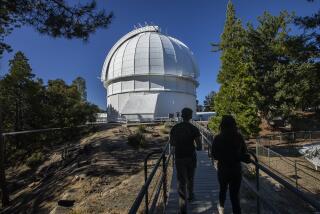Hubble: From Fiasco to Sublime : After a titanic struggle, there’s a marvelous window on the universe
- Share via
It has taken a while and cost a bundle, but the Hubble Space Telescope appears finally to be peering sharply into some of the far reaches of the universe and producing images of truly remarkable clarity, just as it was designed to do. Indeed, says Daniel S. Goldin, the administrator of NASA, “the spacecraft is operating beyond our ambition.” While a lot more testing of the $1.5-billion orbiting telescope is still to be done, astronomers are excited by the early signs of success.
The shame is that the Hubble wasn’t in the same condition when it was launched nearly four years ago. NASA thought it had a winner then, too. But two months after the launching, NASA had to admit that the telescope’s 94.5-inch-diameter mirror had been improperly ground at the edges, a flaw that surely should have been found and rectified on the ground. It took the skills of seven astronauts aboard the space shuttle Endeavor to correct the Hubble’s problems. Their tricky, $629-million rescue mission last month was a feat in itself, and it’s a credit to those who designed and carried it out that it seems to have succeeded so well.
An orbiting observatory gets around the problem of atmospheric interference that Earth-based telescopes confront, making more detailed images of outer space possible. The Hubble, even in its flawed state, was able to send back images that could be strikingly enhanced by computers on the ground, but the sharper focus it’s now expected to have will lead, Goldin promises, to discoveries that until now were beyond reach.
One of its key objectives will be to search for black holes, those theoretical points in the universe that are believed to be the remains of ancient stars that have collapsed into themselves, reducing enormous objects to diameters of perhaps only a few miles. A black hole, it’s hypothesized, consists of matter so dense and thus of such powerful gravitational force that whatever is nearby, including other stars, is drawn into its center. Since not even light can escape from the gravitational grip of a black hole, its existence can only be inferred. The Hubble, among its other potential achievements, might finally provide the means for proving that these fascinating objects are in fact out there. Knowledge of the universe may at this moment stand on the threshold of a great expansion.
More to Read
Sign up for Essential California
The most important California stories and recommendations in your inbox every morning.
You may occasionally receive promotional content from the Los Angeles Times.













